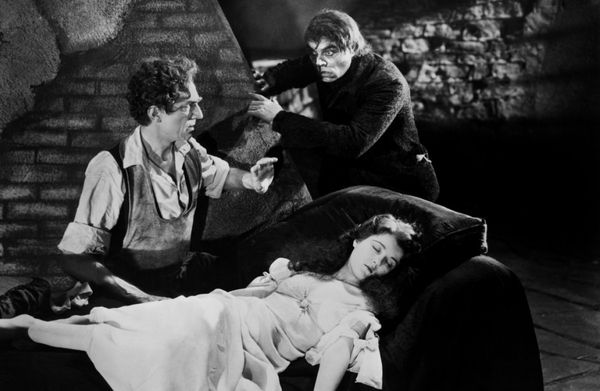Murders in the Rue Morgue (1932)
“Heresy? Do they still burn men for heresy? Then burn me monsieur, light the fire! Do you think your little candle will outshine the flame of truth?” – Doctor Mirakle


With the releases and huge successes of both Frankenstein and Dracula in the previous year, 1932 saw Universal Pictures start to consolidate their embryonic reputation as Hollywood’s # 1 fear factory. A third horror film was hurriedly brought into production, directed by Robert Florey after he had been replaced by James Whale on Frankenstein, and starring as the trailer noted “Dracula himself” Bela Lugosi. For the subject matter, the studio turned to Edgar Allen Poe and his Murders in the Rue Morgue, published in 1841.
Murders in the Rue Morgue is acknowledged as the first ever whodunit mystery, but what Universal wanted was a monster movie, so of course although credited as an adaptation, it’s a very loose adaptation. It’s Poe via the 1919 German silent film Cabinet of Doctor Caligari with its use of carnival sideshows, and nocturnal abductions of young women by a proxy under the influence of a mysterious and powerful Svengali type. Even the rooftop scenes bear a striking resemblance.
Universal sure did love Swan Lake back then, as the main theme is exactly that of Dracula and it’d be used again that same year to introduce audiences to The Mummy.
So, we’re in Paris in 1845, and two young couples are visiting a carnival sideshow, where the barkers vie for the customers’ attention, enticing them to attractions including exotic belly dancers, Wild West shows and a weird show involving a gorilla. It’s to this one that our group are drawn. And it’s here they meet Doctor Mirakle (Bela Lugosi) who invites them to sit near the front.
Mirakle has some then outrageous and heretical theories about evolution, which offends most of the creationist audience. He claims to be able to speak to his gorilla, Erik and invites Camille (Sydney Fox) closer. Erik (alternatively played by stock footage of a chimpanzee – and as if we couldn’t tell the difference – Charles Gamora in an ape suit) has taken a liking to Camille, and snatches her bonnet. But when boyfriend Pierre (Leon Ames) gets too close, Erik tries to strangle him.
Mirakle calls Erik back, and apologetically offers to replace the bonnet, which Pierre haughtily declines. But Mirakle has them followed home by his manservant to find out where she lives.
Mirakle has an obsession with his evolution theory, and is carrying out a series of experiments in his Parisian loft in an abandoned building. He’s luring women, tying them up to cross beams in his loft and drawing blood to see if theirs can be successfully blended with that of Erik, so he can mate them with the gorilla.
It’s unclear whether he’s hoping to mutate a human female into a gorilla, via some weird reverse evolution, or whether she’d retain her humanity for some ape lovin’, but either way, damn – Universal were pushing the boundaries in 1932 weren’t they?
We see Mirakle’s cold, unfeeling manner when he lures a distressed woman who has just seen her two lovers (or more likely her pimp and a customer – who knows?) fight presumably to the death by the Seine. She’s only credited as “a woman of the streets”. Tied up in her underclothes and sobbing, the leering Lugosi taunts her as he cuts away at her arm and berated her for having the wrong blood. “Your blood is as black as your sins” he says as she dies and he springs a trapdoor that dumps her body in the Seine.
Unluckily for Mirakle, Pierre is a medical student and has paid off the morgue attendant for a sample of the victim’s blood, ascertaining there’s something else in the blood (the ape blood that Mirakle’s been toying with) and that the wounds are consistent with two earlier victims.
Foiled again by Pierre when he sends a replacement bonnet to Camille’s house along with an invitation to join him at the carnival tent, Mirakle sends Erik out over the stylised Parisian rooftops to get her and bring her to him. This causes a commotion when Erik is interrupted by Camille’s mother, so Erik kills her and stuffs her in a chimney (don’t ask).
Success! Camille’s blood is compatible with that of Erik – the experiment can go ahead. But Pierre arrives with the authorities just in time. Erik turns on Mirakle and kills him for reasons I don’t understand, before taking to the rooftops with Camille over his shoulder and Pierre in pursuit. Poor Erik meets his maker, shot at point blank range with a musket before rolling off the roof to the cold kiss of the river Seine.
Overall, this film seemed more sadistic in its tone that the earlier two. Lugosi, of course makes the most of his towering stature and his accent and gives one of his most manically menacing performances which compensates for the strange monobrow and tousled hair the makeup department bestowed on him for this role. It’s a brisk 60-minute film, fast paced with no time for character development or nuance, but the sets and backdrops again very similar to the earlier Cabinet of Doctor Caligari evoke the mood instantly. It’s a Universal classic that is almost always overlooked, but it certainly belongs in the line-up. The question is, who really IS the monster here? Is it Erik, or is it that Erik is just another victim of the insane Mirakle – the REAL monster?
